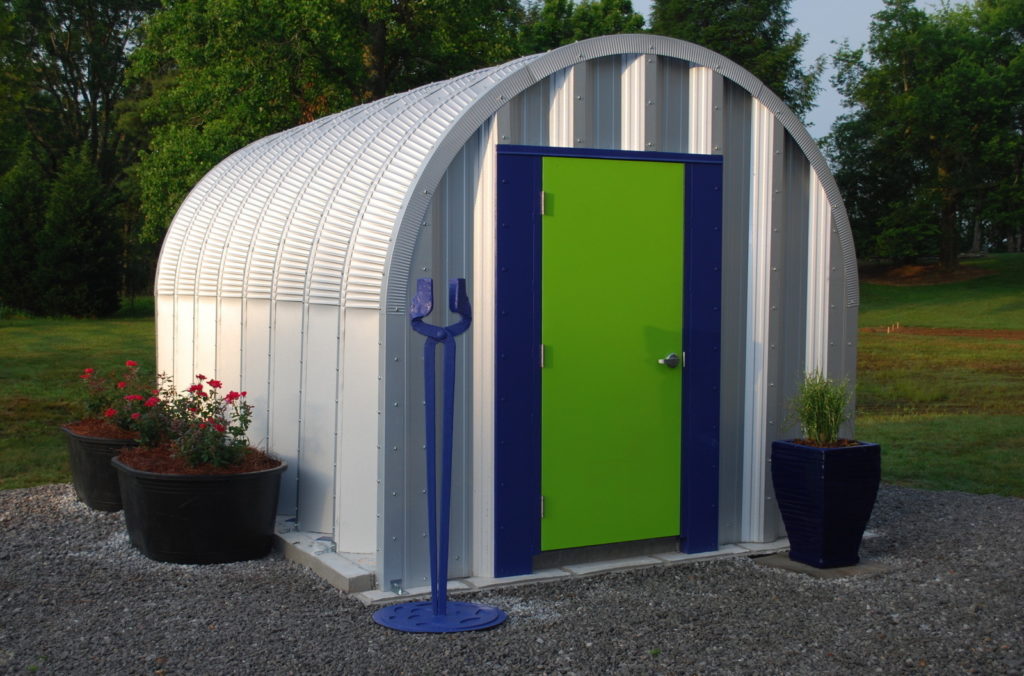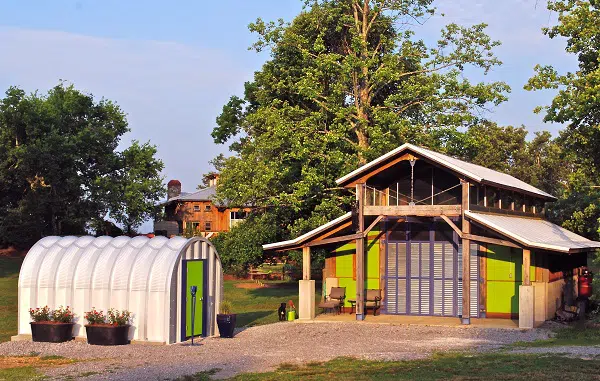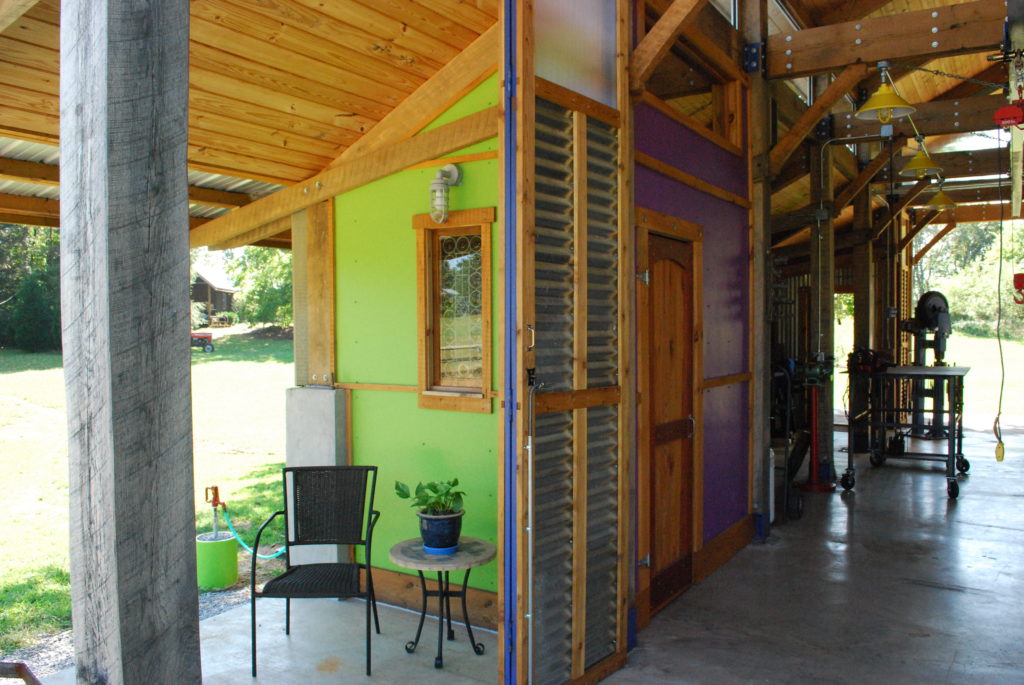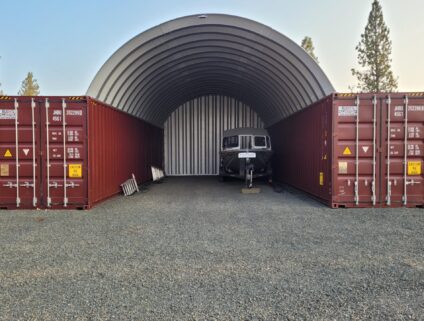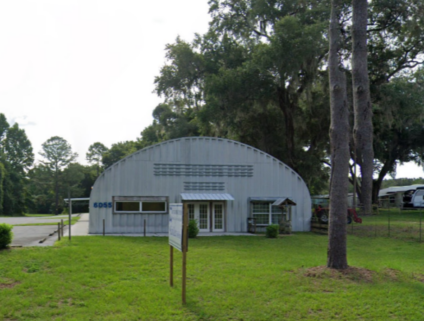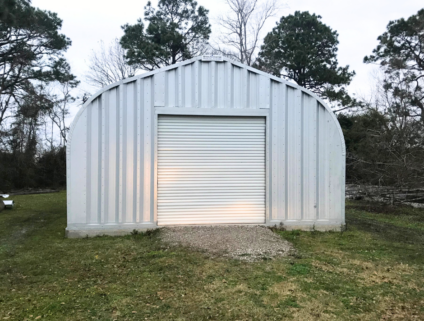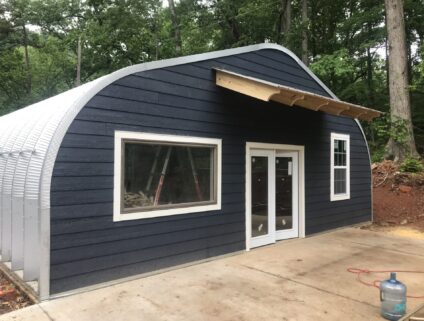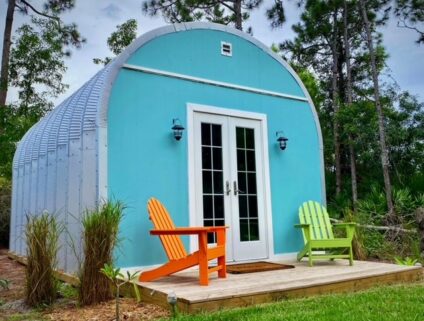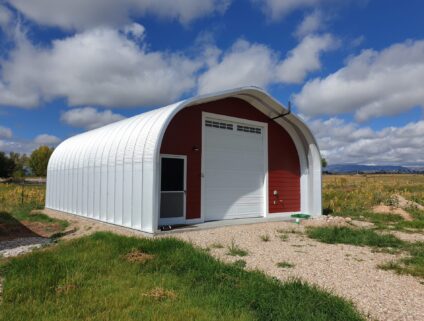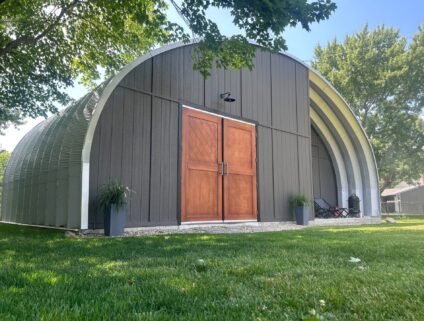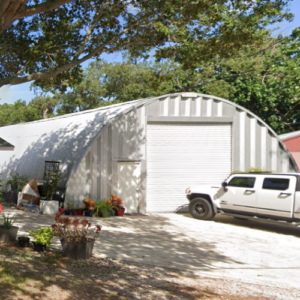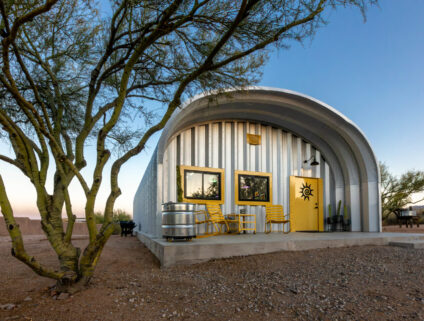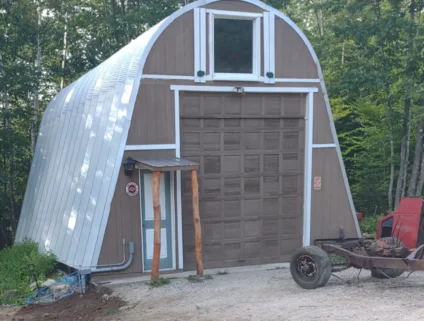The Art of Steel: Blacksmith Stores Metal in Tiny Quonset Hut
Written by Brenda H. Welch
Brenda is a freelance writer and editor living in Hampton Roads, VA
I like surprises, and I experienced one over this past weekend.
My surprise didn’t show up in the form of a party or a winning lottery ticket. There weren’t balloons or noisemakers or any hoopla at all—there was simply a conversation by email.
The person I exchanged emails with is Julie Clark who lives in Rising Fawn, GA with her husband Bruz. I contacted her to get some information about her SteelMaster building, which she uses for storage. What I ended up learning was unexpected and fascinating—Clark is an artist, and her medium is blacksmith and metal working.
What I know about blacksmithing is that it was a common form of employment for men some 200 years ago, and their end result was typically wagon axles, plowshares, swords, and horseshoes. Back then, the blacksmith heated iron or steel, pounded, shaped, and cooled it over and over again until it became what it was meant to be.
Nowadays, the same heating, pounding, and shaping process still goes on, but the end product is typically considered art—with both men and women delivering the mighty blows toward creation.
I was intrigued, so in addition to asking her questions about her SteelMaster storage building (made by SteelMaster Buildings in Virginia Beach, VA), I delved a bit into her own drive to dabble in an art form that requires a lot of fire, smoke, and tools. Here is the interview:
BHW: How long have you been a blacksmith and metal working artist, and what got you into working with that material?
JC: I grew up with horses, and after I graduated from college in 1987, I went to farrier school to learn how to shoe. We made all of the horseshoes in a coal forge, which led to my interest in blacksmithing as an art form. I didn’t begin making art full-time until the mid 90’s.
My husband, Bruz and I spent five years building our own house, and during that time I obtained a two-year degree in welding at a local community college and began playing around with metal work and sculpture.
After we finished the house, we built my shop, SpitFire. Both combine timber frame and post and beam joinery, using a lot of steel brackets to join the timbers. I took the welding classes to gain more knowledge about welding in order to feel comfortable about welding the bracket which hold up the house.
My husband is proficient in woodworking and I love metal, so it is a fabulous combination.
I have my work at InTown Gallery in Chattanooga and also participate in craft fairs.
I also teach a blacksmithing class at the John C. Campbell Folk School in North Carolina.
BHW: What key components do people typically have in a blacksmith shop, and do you have those in yours?
JC: If by components, you are referring to structural, I would have to say a hoist is key. We installed an I-beam with an attached hoist that runs the full length of my shop. I use it often.
With metalworking, fire is always an issue, and even though oak timbers are the support material, the floor is concrete and my interior side walls are concrete and corrugated metal.
Our building has a clear story with windows, which let in much-needed natural light and adequate ventilation comes from being able to open both end doors, allowing wonderful airflow. Plenty of outlets are a must as well, especially for a metal working shop.
If by components, you are referring to equipment, I have various things, to suit my mood. If I am in the mood to forge, I have a propane forge, 250# anvil, post vice, treadle hammer, little giant power hammer, and various other tools. If I am in the mood to weld up a sculpture, I have various welders, plasma cutter, oxy/ace torch and a nice large layout table. Often times an artist will either specialize in blacksmithing or metal working. I am fortunate to have skills and interest in both areas, but when I teach, I always tell my students that you do not need all of the things that I have to get started. You can do a lot with just a few key items, such as a gas forge, small anvil, small welder, and a few tongs and hammers.
BHW: Where did you work on your art before you built the blacksmith shop?
JC: I paid my dues for a number of years in a tiny wooden shed, 10′ x 12′, with a gravel floor that used to house shavings for the horses. I cleaned it out and my husband ran electricity to it. I called it Sparky. I actually loved it and would not have traded my time in it for anything.
I think it is important to work one’s way up to a nice space. I appreciate my new shop, having worked so long in Sparky!
BHW: When did you decide that you wanted to build another stand-alone shop?
JC: When we built the shop, I did not really account for storage for steel. It is not my nature to accumulate huge quantities of steel, or scrap, because I can’t function in clutter. But, after completing the shop and working in it for a couple of years, I knew I needed a dry space for bar stock and sheet metal. What I did accumulate ended up on the floor of my shop, and I had to always step over it. I also have to say, that it was important to find a small building that fits in with my beautiful timber-framed shop. The little [SteelMaster] Quonset hut is a perfect addition. My husband and I are huge believers that a structure, no matter what its use, has to be attractive as well as functional.
BHW: When you realized you needed a place to store your metal and you decided to go with a Quonset hut, what led you to SteelMaster?
JC: We were on a trip in North Carolina, and while on a little country road, we drove past a tiny little Quonset hut that looked like a little garden shop. I did not realize that a hut could be so small, so when I got home, I Googled “Quonset hut”.
A few companies came up and asked for dimensions in order to give a quote. SteelMaster was the first to contact me. The person I talked to was so nice; I never even got quotes from the others. Simple kindness really does pay off.
We followed the instruction for building a form for a pad and had it poured—it took us about four days to put up the frame. We were totally amazed at how easily it went up and that all the bolt holes matched perfectly. We have talked it up so much that a couple of friends came by and they are thinking about building one.
I would highly recommend SteelMaster. We received follow-up calls and my husband had a question about the anchor brackets and received very helpful and friendly answers from someone at the company.
BHW: What is it about the old military-style Quonset huts that you like? Have you seen them in various places throughout your life, or is this an image that you have from movies/TV/etc.?
JC: Good question. I am not really sure, but I have always known about the old military style Quonset huts and thought they were a cool structure. I find the arch visually appealing and I am familiar with the strength of the arch in construction as well having marveled at the ancient French aqueducts.
BHW: Are you confident in your SteelMaster when it comes to durability/resilience?
JC: I must tell you this funny story. When we were building our house, a dear friend was writing an article for Southern Living on good luck charms found in foundations of dwellings all over the world. During medieval times it was not uncommon for the wealthy to sacrifice a human and bury the remains in the foundation. Over time, that led to burying a shoe. So our friend sacrificed his LL Bean loafer to go into our foundation. The tradition continued with my Mom giving up her classic beige pump, which was submerged into the slab for the Quonset.
I am convinced all bring us good luck because a couple of weeks ago, our little town of Trenton, GA was torn to pieces by a tornado. As the crow flies, the town is about five miles west. We had put up the hut, and had it anchored to the slab with brackets, but had not filled in with the grout. A neighbor called to say a tornado had touched down and would be in Trenton in 20 minutes. I went into our lower room and got up against a wall. It was wild, and I sat there thinking, that the Quonset hut would surely be gone. Thankfully, our house, shop, and the Quonset hut came through unscathed. Now, whether it was saved from damage due to luck of the shoe or because of well designed, sturdy components; I’ll let you decide!
BHW: You mentioned in your writing that you thought the Quonset hut would make a great pub…what made you think of that, and can you elaborate just a bit on that thought for me?
JC: My husband and I do enjoy wine, but we are total beer connoisseurs. Complete snobs! I mean, we even named our dog after our favorite beer, Stella Artois. Anyway, so all through our building projects, at the end of the work day, after all the tools were put away, we would look forward to a good beer and to rehash the progress. Our good friend and architect, who helped with the design and construction of both our house and shop, used to kid us about designing a separate building to hold the kegs and running the hoses right into the shop. The minute we put up the adorable Quonset hut, all we could think of was, it would be a great pub for us to house our extensive collection of foreign beer, to have our friends over and to enjoy!
In addition to farming and storage buildings, SteelMaster’s steel and metal pre-engineered buildings are designed for a broad range of residential and commercial applications including garages, workshops, carports, metal barns, Quonsets, airplane hangars, RV storage, roofing systems, military buildings, commercial warehousing, and industrial storage as well as a wide variety of custom building applications including homes, athletic facilities, retail stores, churches, bus stops, smoke shacks, doggie dorms, and correctional facilities.

